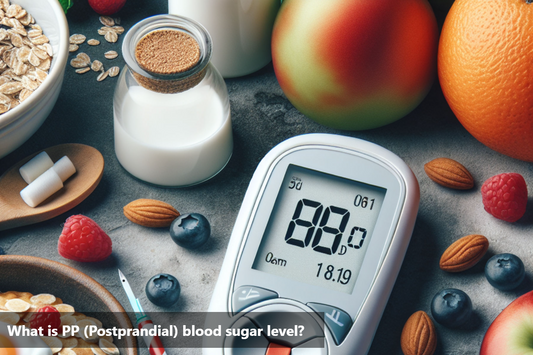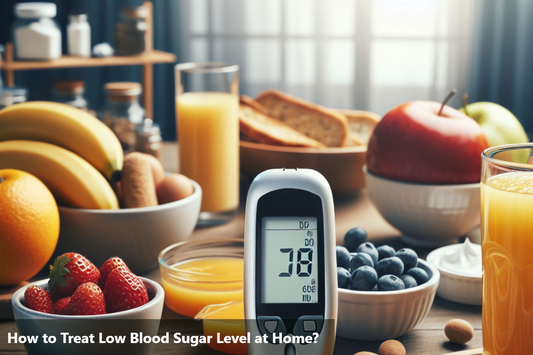Testing blood sugar levels is crucial for managing diabetes. Check before meals, after meals, before exercise, and when symptomatic. Monitoring helps you make informed decisions about food, insulin, and lifestyle.
Fasting Blood Sugar
Fasting blood sugar levels are commonly used to screen for and diagnose diabetes and prediabetes. Here are the general guidelines for interpreting fasting blood sugar levels:
-
A fasting blood sugar level of less than 100 milligrams per deciliter (mg/dL) is considered normal.
Individuals with fasting blood sugar levels in the normal range are generally considered to have good blood sugar control and a lower risk of developing diabetes.
-
Prediabetes:
Fasting blood sugar levels between 100 to 125 mg/dL are indicative of prediabetes, a condition characterized by higher than normal blood sugar levels but not high enough to be diagnosed as diabetes.
Prediabetes increases the risk of developing type 2 diabetes and cardiovascular disease. Lifestyle modifications such as diet and exercise can help prevent or delay the progression to diabetes.
-
Diabetes:
A fasting blood sugar level of 126 mg/dL or higher on two separate occasions is indicative of diabetes.
Additionally, if an individual experiences symptoms of diabetes such as increased thirst, frequent urination, unexplained weight loss, or blurred vision along with a fasting blood sugar level of 200 mg/dL or higher, it is diagnostic of diabetes without the need for a repeat test.
Postprandial Blood Sugar
What Happens to Blood Sugar After Eating? In people without diabetes, blood sugar usually goes up a bit after a meal but stays in a normal range. The American Diabetes Association suggests that for adults with diabetes, blood sugar levels should be below 180 milligrams per deciliter (mg/dL) two hours after eating.
Understanding High Blood Sugar After Meals Having high blood sugar after meals, known as postprandial hyperglycemia, is common in people with diabetes or those with glucose issues. If blood sugar levels stay high for a long time, it can lead to health problems like heart issues, nerve damage, and eye problems.
Why Check Blood Sugar After Meals? While fasting blood sugar gives us a baseline, checking after meals helps us see how the body responds to different foods. High blood sugar after meals might mean you need to adjust your diet, meds, or insulin to stay healthy and avoid complications.
-
Tips to Control Blood Sugar After Meals
Eat foods with a low glycemic index (GI) to keep blood sugar stable.
Have fiber, protein, and good fats to slow down sugar absorption.
Stay active, like going for a walk after eating, to manage blood sugar.
Watch portion sizes and avoid too many carbs to prevent spikes.
Work with healthcare pros to create a plan to manage blood sugar after meals.
How to Check Blood Sugar After Meals You can use a blood sugar meter at home or get tests at the doctor's office. Testing about two hours after eating helps see how your body responds to food. Regular checks can help you see progress, find patterns, and adjust your diabetes plan as needed.
Random Blood Sugar
Indications for Testing:
Checking blood sugar levels randomly can be done as part of regular health check-ups, especially for people at risk of diabetes or those showing signs of high (hyperglycemia) or low (hypoglycemia) blood sugar. Signs of high blood sugar include feeling very thirsty, peeing a lot, tiredness, blurry vision, and slow healing of wounds. Signs of low blood sugar include feeling shaky, sweaty, confused, dizzy, hungry, and easily irritated.
Reading the Results:
Understanding random blood sugar levels depends on different things like age, health, recent meals, medicine use, and any symptoms. For people without diabetes, blood sugar levels typically fall between 70 and 125 milligrams per deciliter (mg/dL). Higher levels could mean high blood sugar. For those with diabetes, levels can change based on how well they follow their treatment plan, diet, exercise, and blood sugar control. The target blood sugar range may differ based on personal health goals and advice from healthcare professionals.
Clinical Importance:
Random blood sugar tests can detect sudden high or low blood sugar spikes, especially for people with diabetes. High levels may point to poor blood sugar control, resistance to insulin, or a need to adjust diabetes treatment, like changing medication or diet. Low levels could mean hypoglycemia, which needs quick treatment with sugary snacks or drinks to raise blood sugar levels.
Monitoring and Care:
Regularly checking random blood sugar levels is crucial for people with diabetes to track blood sugar control, spot patterns, and adjust treatments as needed. People with diabetes should closely work with healthcare providers to set target blood sugar levels, create personalized diabetes plans, and learn how to monitor blood sugar and manage high or low blood sugar levels.
Bottom Line
Regularly checking your blood sugar is really important for staying healthy and managing conditions like diabetes well. Knowing the best times to test your blood sugar can make a big difference in how you feel. It's a good idea to test your blood sugar in the morning before eating, called fasting blood sugar, to see your usual level. This test helps spot any unusual values that could mean you might have prediabetes or diabetes.
Checking your blood sugar after meals, called postprandial blood sugar testing, is crucial to see how your body handles sugar intake during the day. This information can help you make good food choices and manage insulin if you have diabetes. Random blood sugar tests at different times can also give important information, especially if you have symptoms of high or low blood sugar.
Keeping your blood sugar at a healthy level by checking regularly and making lifestyle changes is important for avoiding problems linked to high or low blood sugar. Testing often, following dietary advice, and being active regularly make a big difference in managing blood sugar well. Being proactive and knowing when to check your blood sugar puts you in charge of your health and well-being.
This Blog post is an initiative by DiabeSmart, to provide accurate and Nutritionist / Doctor approved information related to Diabetes. DiabeSmart is India's first Food brand designed specifically for Diabetics, that has been clinically tested on Diabetics and Pre-Diabetics to deliver 55% - 70% lower Sugar spikes. DiabeSmart is part of Lo! Foods - India's leading brand for Everyday Functional Health foods.











